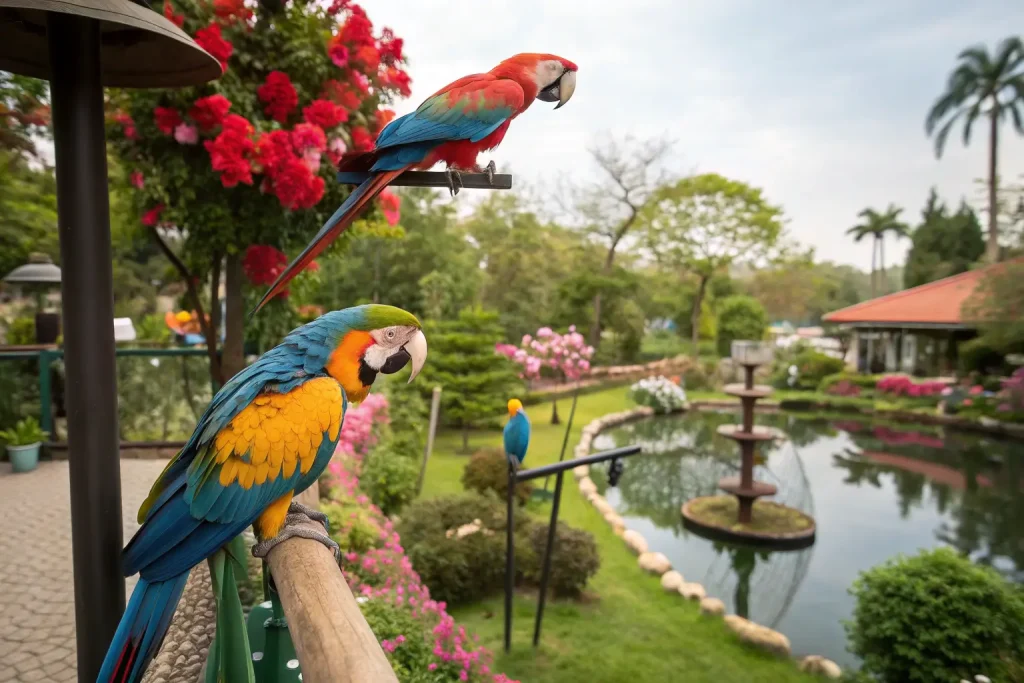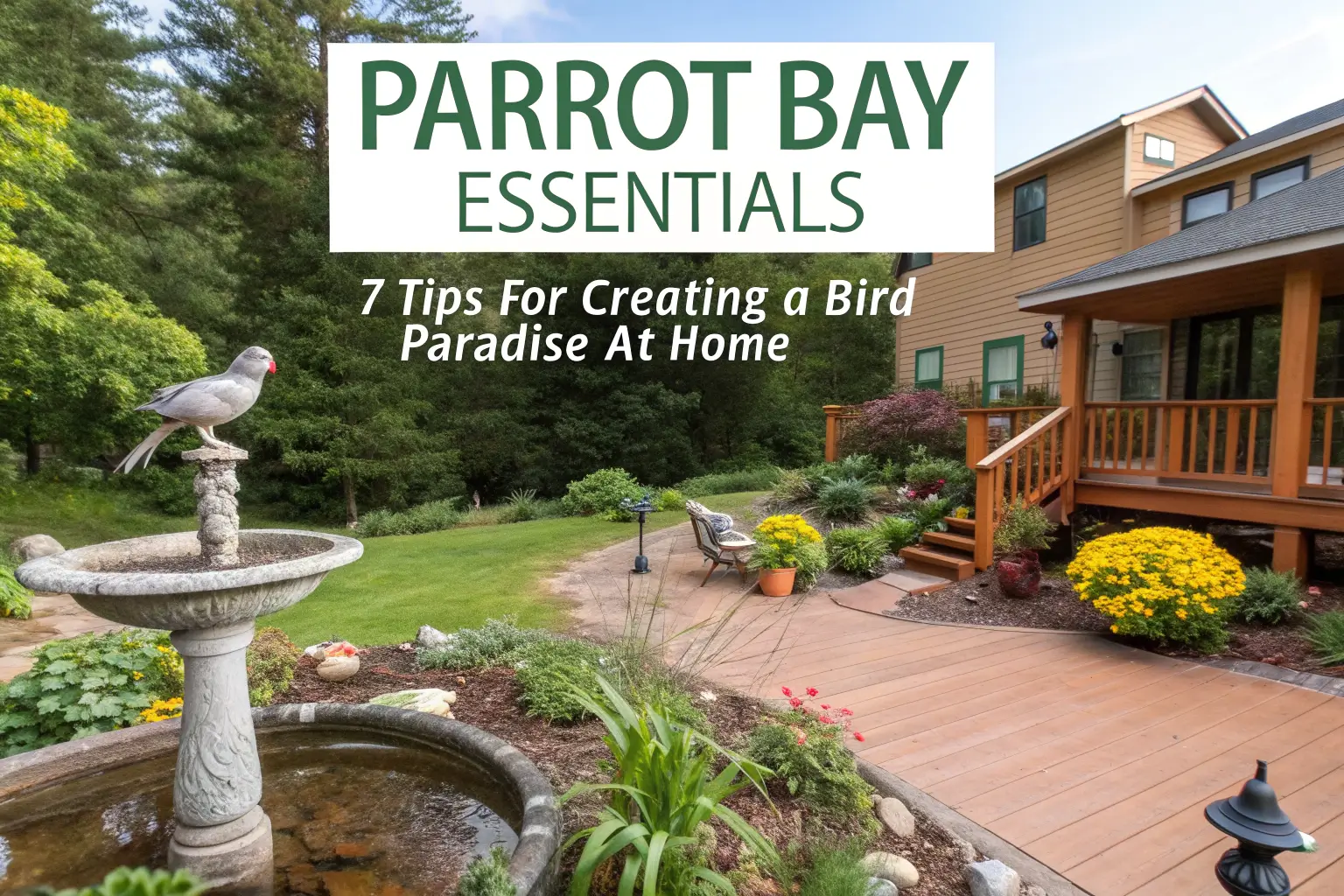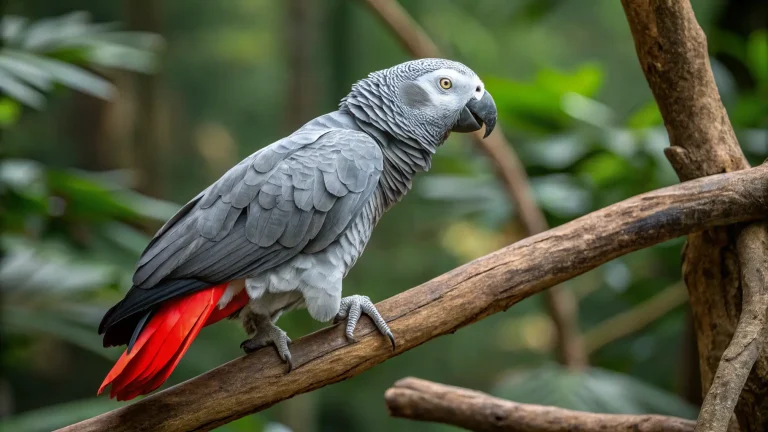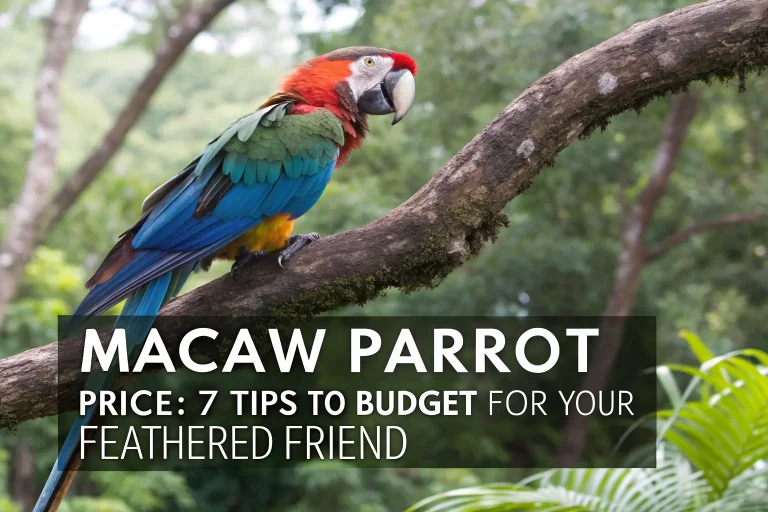Parrot Bay Essentials: 7 Tips for Creating a Bird Paradise at Home
Transform your space into a parrot bay and give your feathered friend a slice of paradise! Get top tips for the perfect bird haven. Discover how today.
Introduction
Parrots are among the most captivating and intelligent companions a person can have. These vibrant, social birds bring endless joy, but they also deserve an environment that nurtures their physical and emotional well-being. Creating a “parrot bay” at home—a personalized paradise designed specifically for your feathered friend—isn’t just a luxury; it’s essential for their health and happiness.
As wild creatures adapted to lush rainforests, vast plains, or tropical islands, parrots need more than a simple cage to thrive. Did you know that some parrot species can live 50+ years in captivity with proper care? This longevity means creating an enriching parrot bay is an investment in decades of companionship.
Whether you’re a new bird parent or looking to upgrade your veteran parrot’s living space, these seven essential tips will transform your home into the ultimate parrot paradise they deserve.
Species Overview
Scientific Name and Classification
When planning your parrot bay, understanding which species you’re accommodating is crucial. The term “parrot” encompasses birds in the order Psittaciformes, which includes over 350 species across multiple families. Common pet parrots include:
- African Greys (Psittacus erithacus)
- Macaws (Ara species)
- Cockatoos (Cacatua species)
- Amazons (Amazona species)
- Budgerigars (Melopsittacus undulatus)
- Cockatiels (Nymphicus hollandicus)
Physical Characteristics
Parrots vary dramatically in size, from tiny lovebirds weighing just 40 grams to massive macaws reaching over a kilogram. Their most defining features include curved beaks, zygodactyl feet (two toes pointing forward, two backward), and often vibrant plumage. Many species display striking color combinations that evolved as social signals in the wild—features that make them eye-catching additions to your home parrot bay.
Subspecies and Variations
Many popular parrot species have multiple subspecies with different coloration patterns and slight behavioral variations. For example, the African Grey has two main subspecies: the Congo African Grey (larger with light gray feathers) and the Timneh African Grey (smaller with darker plumage). Understanding these distinctions helps tailor your parrot bay to your specific bird’s natural tendencies and needs.
Habitat and Distribution
Natural Habitat
In the wild, parrots inhabit diverse ecosystems across the Southern Hemisphere, predominantly in tropical and subtropical regions. Most species thrive in forests where they nest in tree hollows and forage among branches. Others prefer grasslands, scrublands, or even mountainous areas.
Your parrot bay should incorporate elements from these natural habitats. Species from rainforests, like many Amazons, appreciate humidity and lush surroundings, while those from drier regions, such as certain cockatoos, may prefer more open spaces with sunlight.
Geographic Range
Different parrot species hail from specific regions worldwide:
- Macaws and Amazon parrots: Central and South America
- African Greys: Central African rainforests
- Cockatoos and cockatiels: Australia and surrounding islands
- Budgerigars: Australian grasslands
Understanding your parrot’s geographic origins helps you create a more authentic parrot bay experience that resonates with their instinctual preferences.
Adaptations
Wild parrots have remarkable adaptations for their environments—strong beaks for cracking nuts and seeds, specialized digestive systems, and social structures for protection. Your parrot bay should accommodate these evolutionary traits by providing appropriate foods, climbing opportunities, and social interaction that match their natural adaptations.
Diet and Feeding Habits
What Parrots Eat
A well-planned parrot bay includes proper nutrition tailored to your specific species. While seed mixes were once the standard, we now know that most parrots thrive on a varied diet consisting of:
- High-quality formulated pellets (40-60% of diet)
- Fresh vegetables and some fruits (30-40%)
- Limited seeds and nuts (10-20%)
- Occasional protein sources like cooked eggs or legumes
Different species have different nutritional requirements—macaws need more fat from nuts than budgies do, while Amazon parrots may require more fruits in their diet.
Foraging Behavior
In the wild, parrots spend 4-6 hours daily foraging for food—an important behavioral need often neglected in captivity. Your parrot bay should incorporate foraging opportunities through:
- Puzzle toys that dispense treats
- Food hidden in crumpled paper or cardboard
- Hanging vegetables that require manipulation
- Foraging mats or boards with hidden treasures
Research shows that incorporating foraging enrichment reduces behavioral problems by 60-70% in captive parrots.
Dietary Needs
Beyond basic nutrition, consider these essential elements for your parrot bay feeding station:
- Clean, fresh water changed daily
- Calcium sources (cuttlebone or mineral blocks)
- Safe branches for chewing (non-toxic woods like willow or apple)
- Appropriate dish placement and size for your species
Behavior and Social Structure
Social Behavior
Most parrot species are highly social, living in pairs or flocks ranging from a few birds to thousands. This social nature means your parrot bay should account for companionship needs. Options include:
- Multiple birds if space and resources permit
- Significant daily interaction with human flock members
- Visual contact with family activities
- “Flock calls” when you’re in different rooms
Parrots isolated from social interaction often develop destructive behaviors like feather plucking and excessive screaming.
Communication
Parrots communicate through complex vocalizations, body language, and physical displays. Your parrot bay should allow for:
- Spaces where they can call without excessive echo
- Visual contact with family to observe social cues
- Mirrors for some species (though these should be used with caution)
- Audio enrichment like bird sounds or music during alone time
Many parrots learn to mimic human speech and sounds—an ability that evolved from their need to identify flock members and adapt to changing environments.
Mating and Reproduction
Even in a domestic parrot bay, birds follow natural hormonal cycles. Be aware that:
- Many parrots become territorial during breeding season
- Some birds may form pair bonds with humans or objects
- Excessive daylight hours can trigger hormonal behaviors
- Nest-like environments (dark boxes, paper bags) may stimulate breeding behavior
Managing these natural tendencies helps maintain harmony in your parrot bay.
Conservation Status
Endangerment Level
Nearly 30% of parrot species worldwide face extinction threats, making conservation awareness important for any parrot enthusiast. Popular pet species with concerning wild populations include:
- Blue-throated Macaw (Critically Endangered)
- Yellow-crested Cockatoo (Critically Endangered)
- Grey Parrot (Endangered)
- Yellow-headed Amazon (Endangered)
Understanding your parrot’s conservation status fosters appreciation for these remarkable birds and may inspire support for preservation efforts.
Threats
Wild parrot populations face numerous challenges:
- Habitat destruction from deforestation and agriculture
- Illegal trapping for the pet trade
- Climate change affecting food availability
- Introduced predators and competitors
- Disease transmission
By creating an optimal parrot bay at home, you’re providing a sanctuary for a species that may be struggling in the wild.
Conservation Efforts
Several organizations work to protect wild parrots, including:
- World Parrot Trust
- Parrots International
- Bird Life International
Many offer “adoption” programs where your contribution supports conservation projects. Displaying information about these efforts in your parrot bay area educates visitors and demonstrates your commitment to these magnificent birds.
7 Tips for Creating the Ultimate Parrot Bay

1. Design a Spacious and Appropriate Cage
The foundation of any parrot bay is the primary cage—your bird’s personal territory and safe space. Follow these guidelines:
- Select the largest cage possible for your space and budget
- Ensure minimum dimensions appropriate for your species (minimum width: 1.5× wingspan)
- Choose appropriate bar spacing (⅜” for small birds, ¾”-1″ for medium species, larger for macaws)
- Prioritize horizontal bars for climbing
- Select stainless steel or powder-coated construction (avoid cheap, painted cages)
- Position the cage against a wall rather than in the center of a room for security
- Place at eye level or slightly below for most species
Case study: A 2019 avian welfare study found that parrots housed in appropriately sized cages with horizontal bars showed 40% fewer stress behaviors than those in smaller, vertical-barred enclosures.
2. Create Multiple Safe Play Zones
Expand your parrot bay beyond the cage with strategically placed play areas:
- Install ceiling-mounted play gyms in common living areas
- Set up window perches for sunlight and outdoor viewing
- Create tabletop play stations with toys and foraging opportunities
- Designate bird-safe rooms for supervised out-of-cage time
- Install shower perches for bathing enrichment
Rotate these locations periodically to provide environmental variety. An effective parrot bay integrates your bird into family life while offering them choice and stimulation.
3. Prioritize Environmental Enrichment
Mental stimulation is critical in your parrot bay design:
- Rotate toys weekly (keep 3-4 in the cage, store others for rotation)
- Include different toy categories:
- Foraging toys (puzzle feeders, hidden treats)
- Destructible toys (wood, paper, cardboard to shred)
- Interactive toys (bells, swings, ladders)
- Comfort toys (soft, preening materials)
- Match toy size and complexity to your species’ abilities
- Create DIY enrichment from safe household materials (paper rolls, untreated wood)
- Incorporate natural materials like clean branches and plant parts
Expert tip: Dr. Susan Friedman, renowned animal behaviorist, recommends “enrichment schedules” where different activities are available on different days to prevent habituation.
4. Optimize Light and Temperature
Wild parrots experience natural light cycles and specific climate conditions. Your parrot bay should include:
- Natural sunlight through windows (filtered through non-toxic glass)
- Full-spectrum lighting with UVA/UVB output
- 10-12 hours of daylight with gradual transitions
- Consistent temperatures (65-80°F/18-27°C for most species)
- Humidity appropriate to species (40-60% for most, higher for rainforest species)
- Protection from drafts and temperature extremes
- Seasonal adjustments to mirror natural cycles
Research indicates that adequate UVA/UVB exposure improves feather condition, vitamin D metabolism, and natural behaviors in captive parrots.
5. Ensure Safety and Security
A properly designed parrot bay prioritizes safety:
- Remove toxic plants, teflon cookware, and hazardous household items
- Cover windows and mirrors during free-flight time
- Secure ceiling fans and eliminate electrical cord access
- Install child-proof latches on cabinets containing chemicals
- Close toilet lids to prevent drowning
- Create a “bird emergency kit” with styptic powder and avian first aid supplies
- Post emergency vet information visibly
- Consider microchipping your bird and installing security cameras
Remember that some common household items like air fresheners, scented candles, and certain cleaning products can be fatal to sensitive parrot respiratory systems.
6. Schedule Regular Cleaning Protocols
Maintaining hygiene in your parrot bay is essential for health:
- Daily: Change food and water, clean feeding stations, spot-clean droppings
- Weekly: Deep clean cage bars, perches, and toys; replace bedding
- Monthly: Sanitize all accessories with bird-safe disinfectants
- Seasonally: Inspect entire setup for wear and needed replacements
Use bird-safe cleaning products like diluted vinegar (1:1 with water), specialized avian disinfectants, or steam cleaning for stubborn areas.
7. Incorporate Training and Social Spaces
Complete your parrot bay with dedicated areas for mental development:
- Designate a training perch or stand for regular sessions
- Create a “conversation corner” where language interaction occurs daily
- Establish a socialization schedule with different family members
- Include visual access to household activities
- Set up a “parrot playdate” area if you have multiple birds
- Install a camera to monitor behavior when alone
Training sessions of 5-15 minutes several times daily significantly improve parrot welfare and strengthen your bond.
Interesting Facts
- Parrots are among the few animals that can dance in rhythm to music, demonstrating sophisticated neural processing
- The African Grey has the problem-solving abilities of a 5-6 year old child
- Some parrot species can remember hundreds of words and phrases
- Parrots have specialized feathers that produce a fine powder for waterproofing
- Many parrots mate for life in the wild
- The oldest documented parrot lived to 92 years (a Blue and Yellow Macaw)
- Parrot beaks continue growing throughout their lives, requiring constant wear
- Some parrots can see in the ultraviolet light spectrum, perceiving colors invisible to humans
Role in the Ecosystem
Ecological Importance
In their natural habitats, parrots serve vital ecological functions:
- Seed dispersal for countless plant species
- Pollination of flowers, particularly in tropical ecosystems
- Population control of insects and small invertebrates
- Nest creation that later benefits other species
- Soil aeration through ground foraging
By understanding these roles, you gain appreciation for the evolutionary niche your parrot’s ancestors filled.
Impact of Decline
The decline of wild parrot populations has far-reaching consequences:
- Reduced regeneration of fruit-bearing trees
- Altered forest composition and diversity
- Loss of specialized mutualistic relationships with plants
- Cascading effects on other wildlife dependent on parrot-maintained habitats
Creating an educational component in your parrot bay helps spread awareness about these important ecological relationships.
Conclusion
Creating a comprehensive parrot bay at home goes beyond providing basic shelter—it’s about crafting an environment where these remarkable birds can express their natural behaviors, engage their intelligence, and enjoy physical and emotional well-being. By implementing these seven essential tips, you’re not just building a space for your parrot; you’re creating a sanctuary that honors their wild heritage while fostering the special bond between you.
Remember that your parrot bay will evolve over time as you learn more about your specific bird’s preferences and needs. The effort you invest in creating this paradise reflects the commitment these long-lived, sensitive companions deserve.
Take action today by evaluating your current setup against these guidelines. Which elements of your parrot bay could use enhancement? Consider implementing one improvement each week until you’ve created the ultimate avian oasis. Your feathered friend will reward you with vibrancy, interaction, and the unique joy that only a thriving parrot can bring to your home.
Frequently Asked Questions
How much space does my parrot need for an adequate parrot bay?
The minimum cage size depends on your parrot species. For budgies and cockatiels, look for cages at least 24″W × 18″D × 24″H. Medium parrots like conures and Amazons need at least 36″W × 24″D × 36″H. Large macaws require minimum dimensions of 48″W × 36″D × 60″H. Remember, these are minimums—always provide the largest cage your space and budget allow, plus out-of-cage play areas.
How do I know if my parrot is happy with their parrot bay setup?
Happy parrots display balanced behaviors such as singing, talking, playing with toys, foraging, preening (but not excessively), and showing interest in surroundings. Warning signs of an inadequate parrot bay include feather plucking, excessive screaming, stereotypic behaviors (rocking, pacing), aggression, or lethargy. Monitor your bird’s behavior patterns to ensure your parrot bay meets their needs.
Can I keep different parrot species together in my parrot bay?
Generally, housing different parrot species together isn’t recommended. Species have different dietary needs, behavioral patterns, and communication styles that can lead to stress and conflict. Size disparities also create safety concerns. Instead, design separate living spaces within your parrot bay while allowing supervised interaction in neutral territories when appropriate.
What are the most toxic household items I should keep away from my parrot bay?
Critical hazards include: Teflon/non-stick cookware (releases toxic fumes when overheated), scented products (candles, plugins, diffusers), chemical cleaners, lead-containing items, zinc-galvanized materials, treated woods, toxic plants (avocado, chocolate, caffeine), alcohol, medications, and cigarette smoke. Create a buffer zone between your parrot bay and potentially harmful household activities.
How much daily interaction does my parrot need in their parrot bay?
Most companion parrots need a minimum of 2-4 hours of interaction daily, though this varies by species and individual. African Greys and cockatoos typically need more social interaction than budgies or cockatiels. Even when you can’t directly interact, position your parrot bay where your bird can observe and feel part of family activities to fulfill their social needs.




